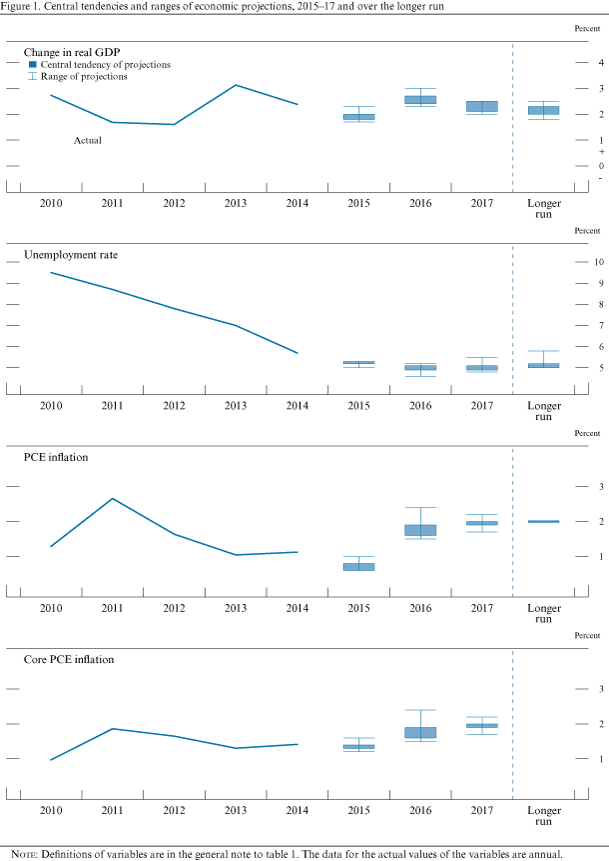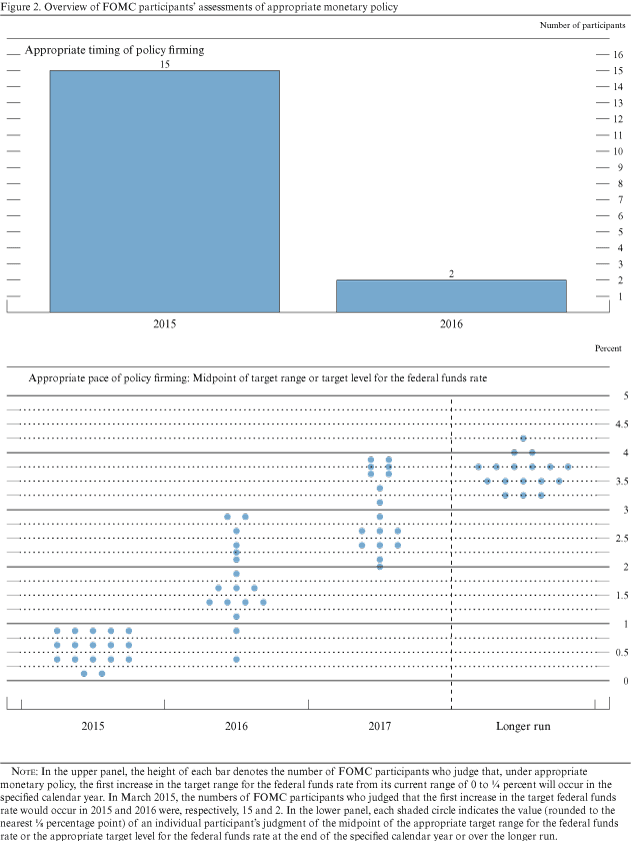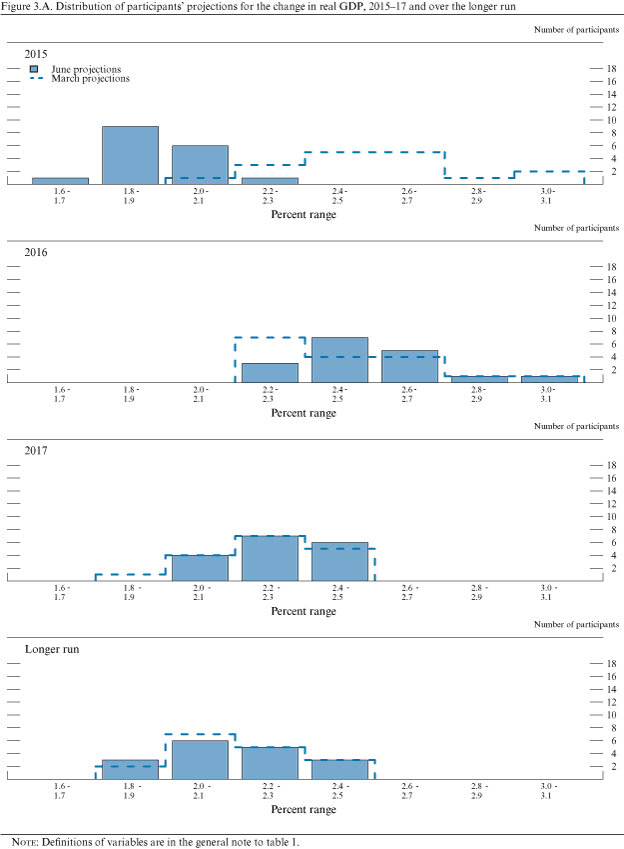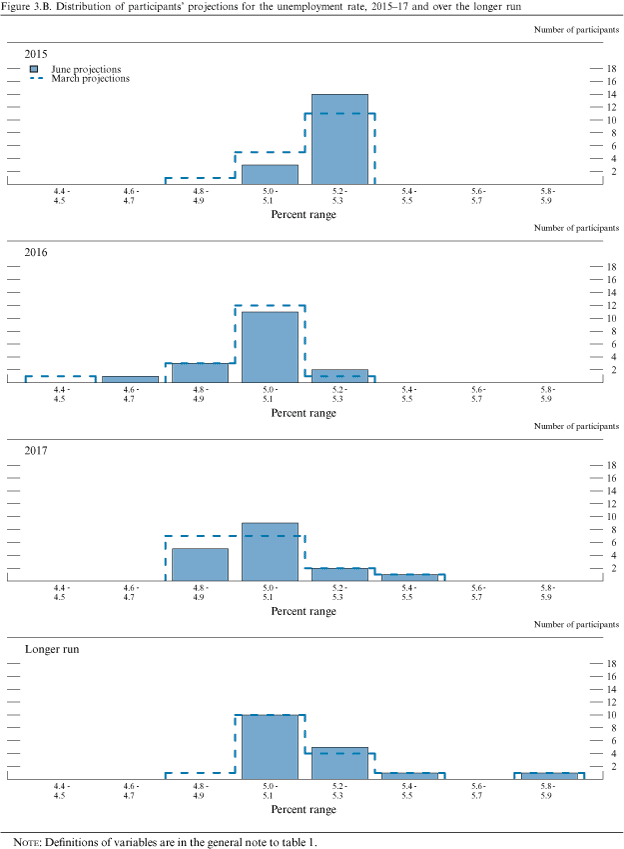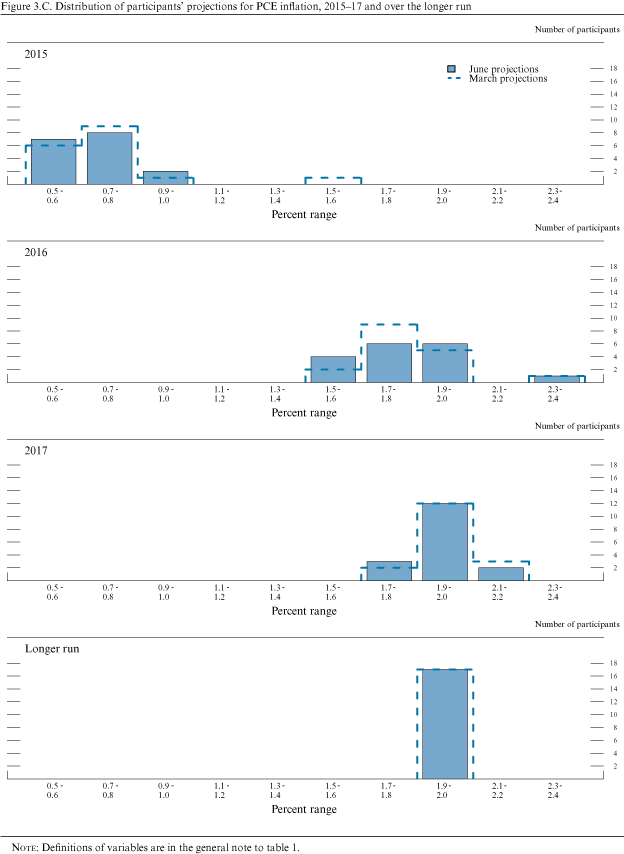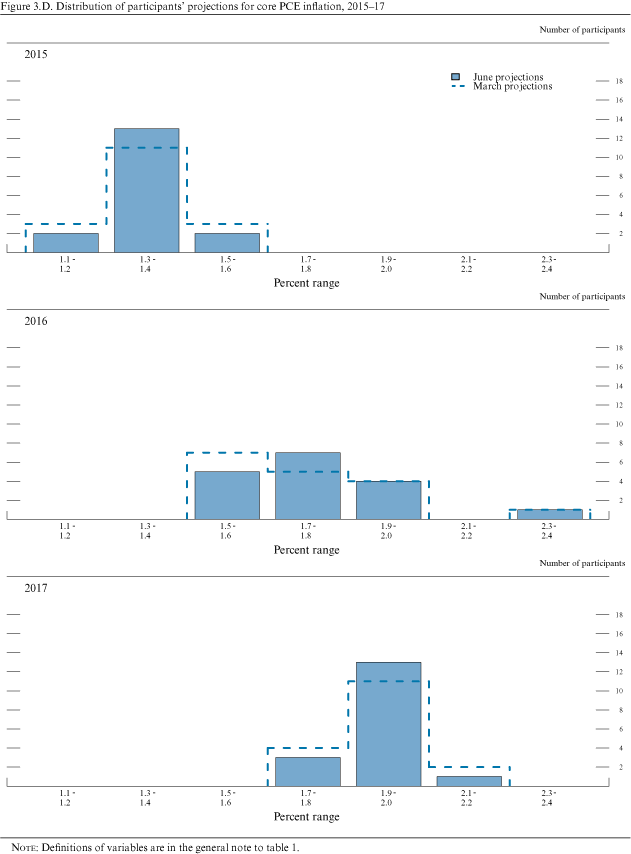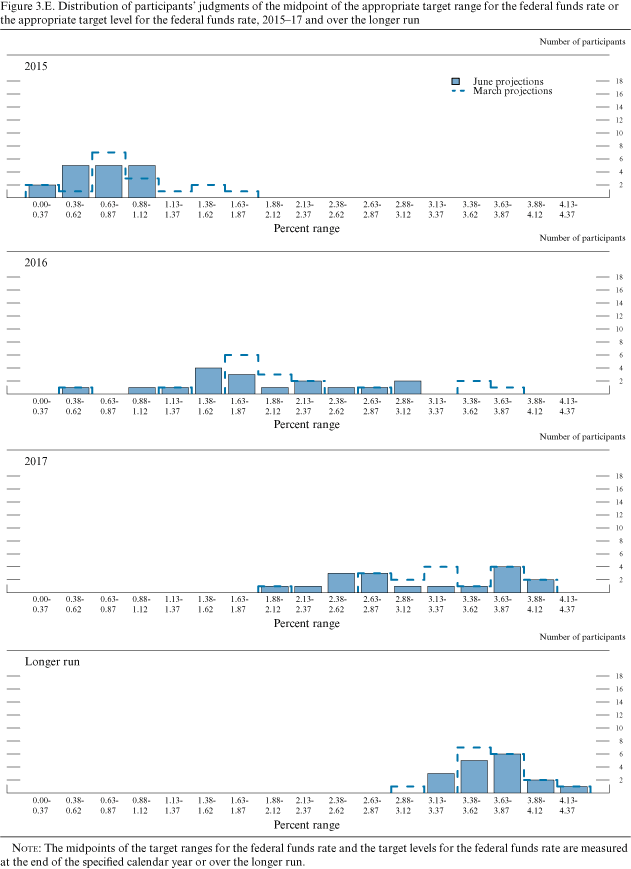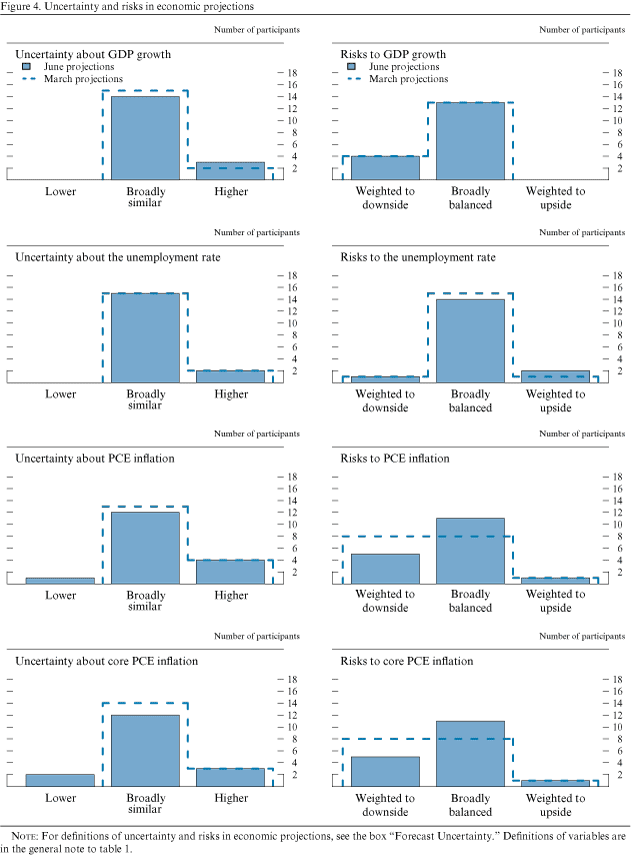- July 15, 2015: Summary
- Part 1
- Part 2
- Part 3
- Abbreviations
- Printable Version (1.32 MB PDF)

Part 3: Summary of Economic Projections
Monetary Policy Report submitted to the Congress on July 15, 2015, pursuant to section 2B of the Federal Reserve ActThe following material appeared as an addendum to the minutes of the June 16-17, 2015, meeting of the Federal Open Market Committee.
In conjunction with the Federal Open Market Committee (FOMC) meeting held on June 16-17, 2015, meeting participants submitted their projections of the most likely outcomes for real output growth, the unemployment rate, inflation, and the federal funds rate for each year from 2015 to 2017 and over the longer run.10 Each participant's projection was based on information available at the time of the meeting together with his or her assessment of appropriate monetary policy and assumptions about the factors likely to affect economic outcomes. The longer-run projections represent each participant's assessment of the value to which each variable would be expected to converge, over time, under appropriate monetary policy and in the absence of further shocks to the economy. "Appropriate monetary policy" is defined as the future path of policy that each participant deems most likely to foster outcomes for economic activity and inflation that best satisfy his or her individual interpretation of the Federal Reserve's objectives of maximum employment and stable prices.
FOMC participants generally expected that, under appropriate monetary policy, growth of real gross domestic product (GDP) in 2015 would be somewhat below their individual estimates of the U.S. economy's longer-run normal growth rate but would increase in 2016 before slowing to or toward its longer-run rate in 2017 (table 1 and figure 1). Participants generally expected that the unemployment rate would continue to decline in 2015 and 2016, and that the unemployment rate would be at or below their individual judgments of its longer-run normal level by the end of 2017. Participants anticipated that inflation, as measured by the four-quarter percent change in the price index for personal consumption expenditures (PCE), would be appreciably below 2 percent this year but expected it to step up next year, and a substantial majority of participants projected that inflation would be at or close to the Committee's goal of 2 percent in 2017.
As shown in figure 2, all but two participants anticipated that further improvement in economic conditions and the economic outlook would make it appropriate to begin raising the target range for the federal funds rate in 2015. The economic outlooks of individual participants implied that it likely would be appropriate to raise the target federal funds rate fairly gradually over the projection period in order to promote labor market conditions and inflation the Committee judges most consistent with attaining its mandated objectives of maximum employment and stable prices. Most participants continued to expect that it would be appropriate for the federal funds rate to stay appreciably below its longer-run level for some time after inflation and unemployment are near mandate-consistent levels, reflecting the effects of remaining headwinds holding back the economic expansion, and other factors.
Most participants viewed the uncertainty associated with their outlooks for economic growth and the unemployment rate as broadly similar to the average level of the past 20 years. Most participants also judged the level of uncertainty about inflation to be broadly similar to the average level of the past 20 years, although some participants viewed it as higher. In addition, most participants continued to see the risks to the outlook for economic growth and for the unemployment rate as broadly balanced, though some viewed the risks to economic growth as weighted to the downside. A majority of participants saw the risks to inflation as balanced; of the five who did not see inflation risks as balanced, four saw risks as tilted to the downside.
Table 1. Economic projections of Federal Reserve Board members and Federal Reserve Bank presidents, June 2015
Percent
| Variable | Central tendency 1 | Range 2 | ||||||
|---|---|---|---|---|---|---|---|---|
| 2015 | 2016 | 2017 | Longer run | 2015 | 2016 | 2017 | Longer run | |
| Change in real GDP |
1.8 to 2.0 |
2.4 to 2.7 |
2.1 to 2.5 |
2.0 to 2.3 |
1.7 to 2.3 |
2.3 to 3.0 |
2.0 to 2.5 |
1.8 to 2.5 |
| March projection |
2.3 to 2.7 |
2.3 to 2.7 |
2.0 to 2.4 |
2.0 to 2.3 |
2.1 to 3.1 |
2.2 to 3.0 |
1.8 to 2.5 |
1.8 to 2.5 |
| Unemployment rate |
5.2 to 5.3 |
4.9 to 5.1 |
4.9 to 5.1 |
5.0 to 5.2 |
5.0 to 5.3 |
4.6 to 5.2 |
4.8 to 5.5 |
5.0 to 5.8 |
| March projection |
5.0 to 5.2 |
4.9 to 5.1 |
4.8 to 5.1 |
5.0 to 5.2 |
4.8 to 5.3 |
4.5 to 5.2 |
4.8 to 5.5 |
4.9 to 5.8 |
| PCE inflation |
0.6 to 0.8 |
1.6 to 1.9 |
1.9 to 2.0 |
2.0 |
0.6 to 1.0 |
1.5 to 2.4 |
1.7 to 2.2 |
2.0 |
| March projection |
0.6 to 0.8 |
1.7 to 1.9 |
1.9 to 2.0 |
2.0 |
0.6 to 1.5 |
1.6 to 2.4 |
1.7 to 2.2 |
2.0 |
| Core PCE inflation 3 |
1.3 to 1.4 |
1.6 to 1.9 |
1.9 to 2.0 |
1.2 to 1.6 |
1.5 to 2.4 |
1.7 to 2.2 |
||
| March projection |
1.3 to 1.4 |
1.5 to 1.9 |
1.8 to 2.0 |
1.2 to 1.6 |
1.5 to 2.4 |
1.7 to 2.2 |
||
Note: Projections of change in real gross domestic product (GDP) and projections for both measures of inflation are from the fourth quarter of the previous year to the fourth quarter of the year indicated. PCE inflation and core PCE inflation are the percentage rates of change in, respectively, the price index for personal consumption expenditures (PCE) and the price index for PCE excluding food and energy. Projections for the unemployment rate are for the average civilian unemployment rate in the fourth quarter of the year indicated. Each participant's projections are based on his or her assessment of appropriate monetary policy. Longer-run projections represent each participant's assessment of the rate to which each variable would be expected to converge under appropriate monetary policy and in the absence of further shocks to the economy. The March projections were made in conjunction with the meeting of the Federal Open Market Committee on March 17-18, 2015.
1. The central tendency excludes the three highest and three lowest projections for each variable in each year. Return to table
2. The range for a variable in a given year includes all participants' projections, from lowest to highest, for that variable in that year. Return to table
3. Longer-run projections for core PCE inflation are not collected. Return to table
The Outlook for Economic Activity
Participants generally projected that, conditional on their individual assumptions about appropriate monetary policy, real GDP would grow slowly in the first half of 2015, but that this near-term weakness would give way to growth in 2016 that exceeds their estimates of its longer-run normal rate; most participants expected real GDP growth to slow in 2017 to rates at or near their individual estimates of the longer-run rate. Participants generally regarded the weakness in economic activity in the first half of this year to be temporary and pointed to a number of factors that they expected would contribute to solid output growth through 2016, including improving labor market conditions, strengthened household and business balance sheets, waning effects of the earlier increases in the exchange value of the dollar, a boost to consumer spending from low energy prices, diminishing restraint from fiscal policy, and still-accommodative monetary policy.Compared with their Summary of Economic Projections (SEP) contributions in March, all participants revised down their projections of real GDP growth for 2015, but many expected the economy to make up at least some of the shortfall over the remainder of the forecast period. Beyond the near term, changes in participants' forecasts were small. The central tendencies of participants' current projections for real GDP growth were 1.8 to 2.0 percent in 2015, 2.4 to 2.7 percent in 2016, and 2.1 to 2.5 percent in 2017. The central tendency of the projections of GDP growth in the longer run was unchanged from March at 2.0 to 2.3 percent.
Most participants projected that the unemployment rate would continue to decline through 2016, and nearly all projected that by the fourth quarter of 2017, the unemployment rate would be at or below their individual judgments of its longer-run normal level. The central tendencies of participants' forecasts for the unemployment rate in the fourth quarter of each year were 5.2 to 5.3 percent in 2015, and 4.9 to 5.1 percent in both 2016 and 2017. Compared with the March SEP, participants' projections for the unemployment rate edged up in 2015 but were little different over the medium term. Several participants indicated that the differences from their March projections for the unemployment rate over the medium term were modest in part because of the monetary policy response that they incorporated into their forecasts to mitigate an otherwise weaker trajectory for expenditures.
Figures 3.A and 3.B show the distribution of participants' views regarding the likely outcomes for real GDP growth and the unemployment rate through 2017 and in the longer run. Some of the diversity of views reflected participants' individual assessments of a number of factors, including the effects of lower oil prices on consumer spending and business investment, the extent to which dollar appreciation would affect real activity, the rate at which the forces that have been restraining the pace of the economic recovery would continue to abate, the trajectory for growth in consumption as labor market slack diminishes, and the appropriate path of monetary policy. Relative to the March SEP, the dispersion of participants' projections for real GDP growth in 2015 narrowed considerably, reflecting in part the release of the national income and product accounts data for the first quarter of this year, which were not available when the FOMC met in March.
The Outlook for Inflation
All participants projected headline PCE inflation to come in at or below 1 percent this year--mostly due to the temporary effects of earlier declines in energy prices and decreases in non-energy import prices--but to climb to 1-1/2 percent or more in 2016. A sizable majority of participants expected that headline inflation would be at or close to the Committee's goal in 2017. Most participants projected only a slight decline in core PCE inflation this year and anticipated a gradual rise over the remainder of the forecast period. Relative to the March SEP, participants' projections for PCE inflation changed very little. The central tendencies for PCE inflation were 0.6 to 0.8 percent in 2015, 1.6 to 1.9 percent in 2016, and 1.9 to 2.0 percent in 2017; for core PCE inflation, the central tendencies were 1.3 to 1.4 percent in 2015, 1.6 to 1.9 percent in 2016, and 1.9 to 2.0 percent in 2017. Factors cited by participants as likely to contribute to inflation rising toward 2 percent included stable longer-term inflation expectations, steadily diminishing resource slack, a pickup in wage growth, the waning effects of declines in energy prices, and still-accommodative monetary policy.Figures 3.C and 3.D provide information on the distribution of participants' views about the outlook for inflation. The range of projections for PCE inflation in 2015 narrowed, albeit mostly on the basis of the lowering of just one projection; otherwise, the ranges of participants' projections for both headline and core PCE inflation were nearly identical to what was reported in March.
Appropriate Monetary Policy
Participants judged that it would be appropriate to begin normalization of monetary policy as labor market indicators and inflation moved to or toward values the Committee regards as consistent with the attainment of its mandated objectives of maximum employment and price stability. As shown in figure 2, all but two participants anticipated that it would be appropriate to begin raising the target range for the federal funds rate during 2015. However, a sizable majority projected that the appropriate level of the federal funds rate would remain below their individual estimates of its longer-run normal level through 2017.All but a few participants projected that the unemployment rate would be at or somewhat above their estimates of its longer-run normal level at the end of the year in which they judged the initial increase in the target range for the federal funds rate would be warranted, and all participants projected that unemployment would decline further after the commencement of normalization. All participants projected that inflation would be below the Committee's 2 percent objective that year, but they also saw inflation rising notably closer to 2 percent in the following year.
Figure 3.E provides the distribution of participants' judgments regarding the appropriate level of the target federal funds rate at the end of each calendar year from 2015 to 2017 and over the longer run. Relative to their March projections, most participants considered a lower level of the federal funds rate to be appropriate over some part of the projection period. The median projection for the federal funds rate at the end of 2015 was unchanged from March at 0.63 percent; however, the mean federal funds rate projection of 0.58 percent for that date was 19 basis points lower than in March. The median projections for the ends of 2016 and 2017 were 1.63 percent and 2.88 percent, respectively--both 25 basis points lower than in March. Compared with the March SEP, the dispersion of the projections for the appropriate level of the federal funds rate was a bit narrower over 2015 and 2016, and about the same as in March for 2017.
A sizable majority of participants judged that it would be appropriate for the federal funds rate at the end of 2017 to remain below its longer-run normal level, with about half of all participants projecting the federal funds rate at that time to be more than 1/2 percentage point lower than their estimates of its longer-run value. Participants provided a number of reasons why they thought it would be appropriate for the federal funds rate to remain below its longer-run normal level for some time after inflation and the unemployment rate were near mandate-consistent levels. These reasons included the expectation that headwinds that have been holding back the recovery would continue to exert some restraint on economic activity, that weak real activity abroad and the recent appreciation of the dollar were likely to persist and temper spending and production in the United States, that residual slack in the labor market would still be evident in some measures of labor utilization other than the unemployment rate, and that the risks to the economic outlook were asymmetric in part because of the constraints on monetary policy associated with the effective lower bound on the federal funds rate.
Relative to the March SEP, participants made at most modest adjustments to their estimates of the longer-run level of the federal funds rate. These changes left the median estimate of the longer-run normal federal funds rate unchanged from March at 3.75 percent; the central tendency for the federal funds rate in the longer run was 3.5 to 3.75 percent, also the same as in March.
Participants' views of the appropriate path for monetary policy were informed by their judgments about the state of the economy, including their estimates of the values of the unemployment rate and other labor market indicators that would be consistent with maximum employment, the extent to which labor market conditions were currently perceived to be falling short of maximum employment, and the prospects for inflation to return to the Committee's longer-term objective of 2 percent over the medium term. Also noted by participants were the implications of international developments for the domestic economy, the uncertainty regarding the reaction by economic decisionmakers to the beginning of policy normalization after a lengthy period with the federal funds rate at the effective lower bound, the economic benefits of limiting any associated disruptions in financial markets, and a general desire to practice risk management in setting monetary policy. In addition, some participants mentioned the prescriptions of various monetary policy rules as factors they considered in judging the appropriate path for the federal funds rate.
Uncertainty and Risks
A large majority of participants continued to judge the levels of uncertainty attending their projections for real GDP growth and the unemployment rate as broadly similar to the norms of the previous 20 years (figure 4).11 As in March, most participants saw the risks to their outlooks for real GDP growth as broadly balanced, although some participants again viewed the risks to real GDP growth as weighted to the downside. Those participants who viewed the risks as weighted to the downside cited, for example, concern about the limited ability of monetary policy to respond to negative shocks to the economy when the federal funds rate is at its effective lower bound, a fragile foreign economic outlook, and weak readings on productivity growth. A large majority of participants judged the risks to the outlook for the unemployment rate to be broadly balanced.Participants generally agreed that the levels of uncertainty associated with their inflation forecasts were broadly similar to historical norms. A few policymakers indicated that their confidence in the likelihood of inflation moving toward the policy objective of 2 percent inflation had increased. In all, 11 participants viewed the risks to their inflation forecast as balanced, up from 8 in the March SEP. The risks were still seen as tilted to the downside by 5 participants who cited the possibility that the effects of the high exchange value of the dollar on domestic inflation could persist for longer than anticipated, that longer-term inflation expectations might coalesce on a lower level of inflation than assumed, or that, in current circumstances, it could be difficult for the Committee to respond effectively to low-inflation outcomes. Conversely, 1 participant saw risks to inflation as weighted to the upside, citing uncertainty about the timing and efficacy of the Committee's withdrawal of monetary policy accommodation.
Table 2. Average historical projection error ranges
Percentage points
| Variable | 2015 | 2016 | 2017 |
|---|---|---|---|
| Change in real GDP 1 |
±1.4 |
±2.0 |
±2.1 |
| Unemployment rate1 |
±0.4 |
±1.2 |
±1.8 |
| Total consumer prices 2 |
±0.8 |
±1.0 |
±1.0 |
Note: Error ranges shown are measured as plus or minus the root mean squared error of projections for 1995 through 2014 that were released in the summer by various private and government forecasters. As described in the box "Forecast Uncertainty," under certain assumptions, there is about a 70 percent probability that actual outcomes for real GDP, unemployment, and consumer prices will be in ranges implied by the average size of projection errors made in the past. For more information, see David Reifschneider and Peter Tulip (2007), "Gauging the Uncertainty of the Economic Outlook from Historical Forecasting Errors," Finance and Economics Discussion Series 2007-60 (Washington: Board of Governors of the Federal Reserve System, November), available at www.federalreserve.gov/pubs/feds/2007/200760/200760abs.html; and Board of Governors of the Federal Reserve System, Division of Research and Statistics (2014), "Updated Historical Forecast Errors," memorandum, April 9, www.federalreserve.gov/foia/files/20140409-historical-forecast-errors.pdf
1. Definitions of variables are in the general note to table 1. Return to table
2. Measure is the overall consumer price index, the price measure that has been most widely used in government and private economic forecasts. Projection is percent change, fourth quarter of the previous year to the fourth quarter of the year indicated. Return to table
Forecast Uncertainty
The economic projections provided by the members of the Board of Governors and the presidents of the Federal Reserve Banks inform discussions of monetary policy among policymakers and can aid public understanding of the basis for policy actions. Considerable uncertainty attends these projections, however. The economic and statistical models and relationships used to help produce economic forecasts are necessarily imperfect descriptions of the real world, and the future path of the economy can be affected by myriad unforeseen developments and events. Thus, in setting the stance of monetary policy, participants consider not only what appears to be the most likely economic outcome as embodied in their projections, but also the range of alternative possibilities, the likelihood of their occurring, and the potential costs to the economy should they occur.
Table 2 summarizes the average historical accuracy of a range of forecasts, including those reported in past Monetary Policy Reports and those prepared by the Federal Reserve Board's staff in advance of meetings of the Federal Open Market Committee. The projection error ranges shown in the table illustrate the considerable uncertainty associated with economic forecasts. For example, suppose a participant projects that real gross domestic product (GDP) and total consumer prices will rise steadily at annual rates of, respectively, 3 percent and 2 percent. If the uncertainty attending those projections is similar to that experienced in the past and the risks around the projections are broadly balanced, the numbers reported in table 2 would imply a probability of about 70 percent that actual GDP would expand within a range of 1.6 to 4.4 percent in the current year, 1.0 to 5.0 percent in the second year, and 0.9 to 5.1 percent in the third year. The corresponding 70 percent confidence intervals for overall inflation would be 1.2 to 2.8 percent in the current year and 1.0 to 3.0 percent in the second and third years.
Because current conditions may differ from those that prevailed, on average, over history, participants provide judgments as to whether the uncertainty attached to their projections of each variable is greater than, smaller than, or broadly similar to typical levels of forecast uncertainty in the past, as shown in table 2. Participants also provide judgments as to whether the risks to their projections are weighted to the upside, are weighted to the downside, or are broadly balanced. That is, participants judge whether each variable is more likely to be above or below their projections of the most likely outcome. These judgments about the uncertainty and the risks attending each participant's projections are distinct from the diversity of participants' views about the most likely outcomes. Forecast uncertainty is concerned with the risks associated with a particular projection rather than with divergences across a number of different projections.
As with real activity and inflation, the outlook for the future path of the federal funds rate is subject to considerable uncertainty. This uncertainty arises primarily because each participant's assessment of the appropriate stance of monetary policy depends importantly on the evolution of real activity and inflation over time. If economic conditions evolve in an unexpected manner, then assessments of the appropriate setting of the federal funds rate would change from that point forward.
Footnotes
10.The incoming president of the Federal Reserve Bank of Philadelphia assumed office after the June FOMC meeting, on July 1, and a new president of the Federal Reserve Bank of Dallas has yet to be selected. Blake Prichard and Helen E. Holcomb, first vice presidents of the Federal Reserve Banks of Philadelphia and Dallas, respectively, submitted economic projections. Return to text
11.Table 2 provides estimates of the forecast uncertainty for the change in real GDP, the unemployment rate, and total consumer price inflation over the period from 1995 through 2014. At the end of this summary, the box "Forecast Uncertainty" discusses the sources and interpretation of uncertainty in the economic forecasts and explains the approach used to assess the uncertainty and risks attending the participants' projections. Return to text

